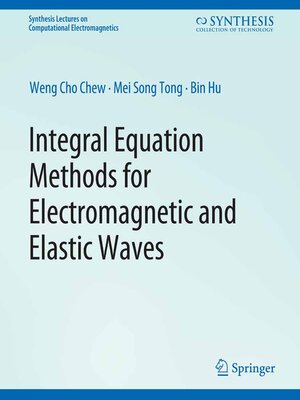Integral Equation Methods for Electromagnetic and Elastic Waves
ebook ∣ Synthesis Lectures on Computational Electromagnetics
By Weng Chew

Sign up to save your library
With an OverDrive account, you can save your favorite libraries for at-a-glance information about availability. Find out more about OverDrive accounts.
Find this title in Libby, the library reading app by OverDrive.



Search for a digital library with this title
Title found at these libraries:
| Loading... |
Integral Equation Methods for Electromagnetic and Elastic Waves is an outgrowth of several years of work. There have been no recent books on integral equation methods. There are books written on integral equations, but either they have been around for a while, or they were written by mathematicians. Much of the knowledge in integral equation methods still resides in journal papers. With this book, important relevant knowledge for integral equations are consolidated in one place and researchers need only read the pertinent chapters in this book to gain important knowledge needed for integral equation research. Also, learning the fundamentals of linear elastic wave theory does not require a quantum leap for electromagnetic practitioners. Integral equation methods have been around for several decades, and their introduction to electromagnetics has been due to the seminal works of Richmond and Harrington in the 1960s. There was a surge in the interest in this topic in the 1980s (notably the work of Wilton and his coworkers) due to increased computing power. The interest in this area was on the wane when it was demonstrated that differential equation methods, with their sparse matrices, can solve many problems more efficiently than integral equation methods. Recently, due to the advent of fast algorithms, there has been a revival in integral equation methods in electromagnetics. Much of our work in recent years has been in fast algorithms for integral equations, which prompted our interest in integral equation methods. While previously, only tens of thousands of unknowns could be solved by integral equation methods, now, tens of millions of unknowns can be solved with fast algorithms. This has prompted new enthusiasm in integral equation methods. Table of Contents: Introduction to Computational Electromagnetics / Linear Vector Space, Reciprocity, and Energy Conservation / Introduction to Integral Equations / Integral Equations for Penetrable Objects / Low-Frequency Problems in Integral Equations / Dyadic Green's Function for Layered Media and Integral Equations / Fast Inhomogeneous Plane Wave Algorithm for Layered Media / Electromagnetic Wave versus Elastic Wave / Glossary of Acronyms






